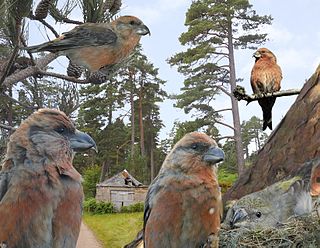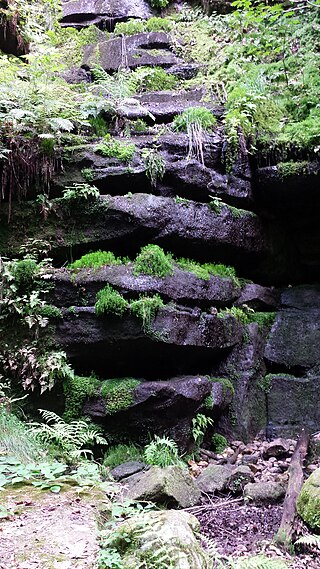
The Scottish crossbill is a small passerine bird in the finch family Fringillidae. It is endemic to the Caledonian Forests of Scotland, and is the only terrestrial vertebrate species endemic to the United Kingdom. The Scottish crossbill was confirmed as a unique species in August 2006, on the basis of having a distinctive bird song.

The fauna of Scotland is generally typical of the northwest European part of the Palearctic realm, although several of the country's larger mammals were hunted to extinction in historic times and human activity has also led to various species of wildlife being introduced. Scotland's diverse temperate environments support 62 species of wild mammals, including a population of wild cats, important numbers of grey and harbour seals and the most northerly colony of bottlenose dolphins in the world.

The flora of Scotland is an assemblage of native plant species including over 1,600 vascular plants, more than 1,500 lichens and nearly 1,000 bryophytes. The total number of vascular species is low by world standards but lichens and bryophytes are abundant and the latter form a population of global importance. Various populations of rare fern exist, although the impact of 19th-century collectors threatened the existence of several species. The flora is generally typical of the north-west European part of the Palearctic realm and prominent features of the Scottish flora include boreal Caledonian forest, heather moorland and coastal machair. In addition to the native species of vascular plants there are numerous non-native introductions, now believed to make up some 43% of the species in the country.
Bryoerythrophyllum caledonicum, commonly known as Scottish beardmoss, is a moss endemic to Scotland. Recognised as a distinct species in 1982, it had been collected occasionally from 1891 onwards under other names. The largest populations are in the Breadalbane mountains including Ben Lawers with smaller populations in mainland Lochaber and on the islands of Skye and Rùm. It has a very restricted habitat, growing only on damp montane schist or basalt ledges. The species has been provisionally classified as Low Risk and receives protection under the Wildlife and Countryside Act 1981.

Hylocomium splendens, commonly known as glittering woodmoss, splendid feather moss, stairstep moss, and mountain fern moss, is a perennial clonal moss with a widespread distribution in Northern Hemisphere boreal forests. It is commonly found in Europe, Russia, Alaska and Canada, where it is often the most abundant moss species. It also grows in the Arctic tundra and further south at higher elevations in, for example, northern California, western Sichuan, East Africa, Australia, New Zealand and the West Indies. In Scotland it is a characteristic species of the Caledonian Forest. Under the UK's national vegetation classification system, pinewood community W18 is named as "Pinus sylvestris-Hylocomium splendens woodland", indicating its significance in this ecosystem.
Bryum dixonii, commonly known as Dixon's threadmoss, is a moss endemic to Scotland. The species occupies montane habitats, and although rare it has a wide distribution including the central and north-west Highlands, and the islands of Skye, Rùm and St Kilda. Originally discovered on Ben Narnain, Argyll, in 1898 by Hugh N. Dixon, it was not seen again until 1964 when found by Ursula Duncan at Juanjorge in Glen Clova in Angus. As of 2000 there was no species action plan for its protection.
Marsupella arctica, commonly known as Arctic rustwort, is a species of liverwort found in the Northern Hemisphere. It is present in Alaska and Greenland and has a European distribution confined to Scotland and Svalbard. The Scottish population was first discovered in 1989 and is restricted to two sites in the Cairngorm mountains - the Lairig Ghru and Beinn a' Bhùird.
Hygrohypnum styriacum, commonly known as snow brook-moss or hygrohypnum moss is a species of moss found in the Northern Hemisphere.
Didymodon mamillosus, commonly known as Perthshire beardmoss, is a species of moss endemic to Europe. It occurs at only five sites including one in Scotland where it is classified as "Critically Endangered". The other sites are in Iceland, Germany, the Czech Republic and in north-east Spain.

Tetrodontium brownianum is a species of moss commonly known as Brown's tetrodontium moss or Brown's four-tooth moss. It is widely distributed. In North America it is found in Washington state and British Columbia on the west coast and from Newfoundland to Ohio to the east. It is also present in Austria, France, Germany, Ireland, Norway, Sweden, Switzerland and the United Kingdom as well as Japan, New Zealand and Chile.

Andreaea frigida, commonly known as icy rockmoss, is a moss endemic to Europe which is found in mountainous regions in Austria, the Czech Republic, France, Germany, Hungary, Italy, Norway, Romania, Poland, and Spain. In the UK its occurrence is widespread in the Cairngorms National Park, where it is typically found on rocks in burns fed by snow patches, but it is not found elsewhere except at a single site in the Lake District of England.
Athyrium flexile, commonly known as Newman's lady-fern or the flexile lady fern, is a taxon of which is fern endemic to Scotland, it has been regarded as a species but it is considered to be an ecotype of the Alpine lady fern. This fern is pale to yellow green in colour and has elliptic, double pinnate leaves which are deciduous. This ecotype grows more quickly and matures faster than the Alpine lady fern in substrates which have low levels of nutrients and is outcompeted by the Alpine lady fern in other situations.
Jamesiella scotica is a species of lichen thought to be endemic to the United Kingdom and Ireland. In the UK, it occurs in montane habitats in England, Wales and Scotland at heights of over 200 metres, thriving on decomposing bryophytes on base-rich soils.
Graphis alboscripta, commonly known as white script lichen, is a species of epiphytic lichen that is endemic to the west coast of Scotland. Nationally rare, its distribution is confined to hazel woodlands.
Tayloria lingulata, commonly known as lingulate dung moss, tongue-leaved gland-moss, or marsh collar-moss, is a moss found in montane habitats in the Northern Hemisphere including Europe, Asia and North America.

Plagiomnium medium, commonly known as Alpine thyme-moss or intermediate plagiomnium moss, is a moss found in montane habitats in the Northern Hemisphere.
Anomobryum julaceum, the slender silver-moss, is a species of bryophyte native to all continents except South America and Antarctica. A. julaceum is found widespread in the temperate regions of the Northern and Southern Hemispheres. Its capsules mature beginning in late fall and through the spring. It is most commonly found in wet crevices and on sandstone cliffs. Additional micro-habitats include tussock tundra with seeps and late snow melt areas and on granitic outcrops. In eastern North America it appears to be restricted to acid habitats, in the wet crevices of sandstone cliffs or other seepy niches. Overall, A. julaceum resembles species of the genus Pohlia, and its leaves are similar to those of Bryum argenteum; it can only be separated from Pohlia and Bryum using a microscope. Anomobryum julaceum can be distinguished from Bryum argenteum by its strongly julaceous, shiny leaves.

The biodiversity of Wales is the wide variety of ecosystems, living organisms, and the genetic makeups found in Wales.
Fissidens celticus, also known by its common name Welsh pocket-moss, is a species of moss in the family Fissidentaceae. It was discovered in 1958 in Pembrokeshire by A.H. Norkett and was first described as a new species by Jean Paton in 1965.







